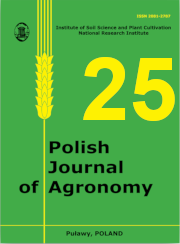Mycotoxin contamination of grain of selected winter wheat genotypes
Main Article Content
Abstract
This study defines several mycotoxin (Aflatoxin B1, Aflatoxin B2, Aflatoxin G1, Aflatoxin G2, Ochratoxin A, De- oxynivalenol, Zearalenone, Toxin T-2, Toxin HT-2, Nivalenol, Fusarenon X, 3-Acetyl-deoxynivalenol) contamination of winter common, durum, spelt and einkorn wheat genotypes. The com- pared species (Triticum aestivum ssp. vulgare, T. durum, T. aesti- vum ssp. spelta and T. monococcum) have different susceptibility to Fusarium and toxin accumulation. Durum wheat (cv. Komnata) was the most susceptible to contamination with mycotoxins. In du- rum grain the highest level of contamination was detected, espe- cially with Deoxynivalenol (2–4 times over the allowed level for unprocessed grain). T. aestivum ssp. spelta (cv. Schwabenkorn) and T. monococcum (EN 5003) showed the lowest mycotoxin level. Triticum aestivum ssp. vulgare (cv. Tonacja) was less contami- nated with mycotoxins than Triticum durum but more than T. aes- tivum ssp. spelta and T. monococcum. Other mycotoxins in grain of the examined genotypes occurred in trace amounts.
Article Details

This work is licensed under a Creative Commons Attribution-ShareAlike 4.0 International License.
The author grants the editorial staff of the Polish Journal of Agronomy (abbreviated as PJA) a non-exclusive and royalty-free license to use the author's copyright in the paper/printed and electronic versions of his/her work published in PJA in Poland and abroad, in whole or in any part, including placing the work in electronic databases/databases locally or available on the Internet, for an unlimited period of time in the fields of exploitation specified in article 50 of the Copyright and Related Rights Act.
Manuscripts published in Polish Journal of Agronomy are available under a Creative Commons Attribution-ShareAlike 4.0 (CC-BY-SA) license.

